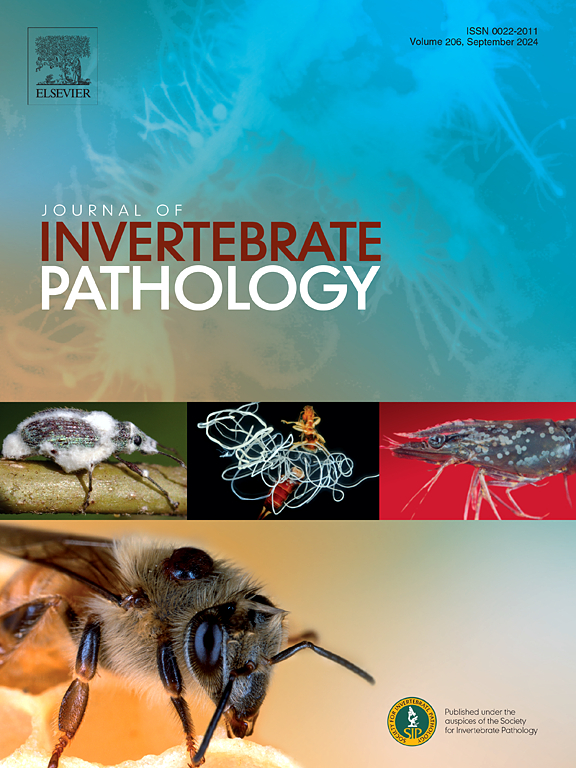马尼拉蛤血细胞对两种在宿主体内具有截然不同增殖动态的珀金斯鱼(P. Olseni 和 p. Mediterraneus)的反应中吞噬体酸化的差异。
IF 3.6
3区 生物学
Q1 ZOOLOGY
引用次数: 0
摘要
Perkinsus属是影响贝类的一类重要致病原生动物,了解决定其宿主范围的因素对于防止其传播和设计有效的控制措施至关重要。考虑到在宿主体内增殖能力的差异可能会影响宿主范围的确定,我们首先向马尼拉蛤蜊 Ruditapes philippinarum 中注射了六种 Perkinsus,并监测滋养体数量的变化。虽然在感染后 28 天,我们在受到挑战的蛤蜊体内检测到了所有六个物种,但不同物种的感染强度各不相同,尤其是两个物种的感染趋势截然不同:P.mediterraneus的感染率呈下降趋势,降至最低强度,而P.olseni的感染率则持续上升,达到最高强度。体外暴露于马尼拉蛤血细胞后发现,P. mediterraneus 滋养体的存活受到抑制,而 P. olseni 滋养体则保持存活。尽管两个物种的吞噬指数相似,但吞噬介壳虫的血细胞的吞噬体酸化率明显高于吞噬奥尔森虫的血细胞。值得注意的是,吞噬活的奥氏原虫滋养体的血细胞的吞噬体酸化明显受到抑制,这表明奥氏原虫可能会分泌一种物质来调节吞噬体的酸化,从而逃避宿主血细胞的细胞内消化。相反,对马尼拉蛤的感染亲和力较低的麦地那龙线虫却没有表现出这种调节作用。基于这些结果,我们认为调节宿主血细胞中吞噬体酸化的能力可能是决定珀金斯属物种宿主范围的至少一个因素。本文章由计算机程序翻译,如有差异,请以英文原文为准。

Differences in phagosome acidification of Manila clam hemocytes in response to two Perkinsus species with contrasting proliferation dynamics in the host: P. olseni and P. mediterraneus
Understanding the factors determining the host ranges of Perkinsus spp., a significant group of pathogenic protozoans affecting shellfish, is essential for preventing their spread and designing effective control measures. Considering that differences in the ability to proliferate within the host may influence the determination of host range, we first injected six Perkinsus spp. into Manila clams Ruditapes philippinarum and monitored the variations of trophozoite numbers. Although all six species were detected in the challenged clams 28 days post infection, the infection intensities varied among species, and particularly two species showed contrasting infection trends: P. mediterraneus showed a decreasing trend of infection, declining to the lowest intensity, whereas that of P. olseni continuously increased, reaching the highest intensity. In vitro exposure to Manila clam hemocytes revealed that the survival of P. mediterraneus trophozoites was suppressed, in contrast to P. olseni, which maintained their viability. Despite similar phagocytic indices for both species, the rate of phagosome acidification was significantly higher for hemocytes phagocytizing P. mediterraneus than those targeting P. olseni. Notably, phagosome acidification was significantly suppressed in hemocytes phagocytizing live P. olseni trophozoites, suggesting that P. olseni may secrete a substance that modulates phagosome acidification, and thereby evades intracellular digestion by the host’s hemocytes. Conversely, P. mediterraneus, with a lower affinity for infecting Manila clams, did not exhibit such modulation. Based on these results, we consider that the ability to modulate phagosome acidification in host hemocytes might be at least one factor in determining the host range of Perkinsus species.
求助全文
通过发布文献求助,成功后即可免费获取论文全文。
去求助
来源期刊
CiteScore
6.10
自引率
5.90%
发文量
94
审稿时长
1 months
期刊介绍:
The Journal of Invertebrate Pathology presents original research articles and notes on the induction and pathogenesis of diseases of invertebrates, including the suppression of diseases in beneficial species, and the use of diseases in controlling undesirable species. In addition, the journal publishes the results of physiological, morphological, genetic, immunological and ecological studies as related to the etiologic agents of diseases of invertebrates.
The Journal of Invertebrate Pathology is the adopted journal of the Society for Invertebrate Pathology, and is available to SIP members at a special reduced price.

 求助内容:
求助内容: 应助结果提醒方式:
应助结果提醒方式:


